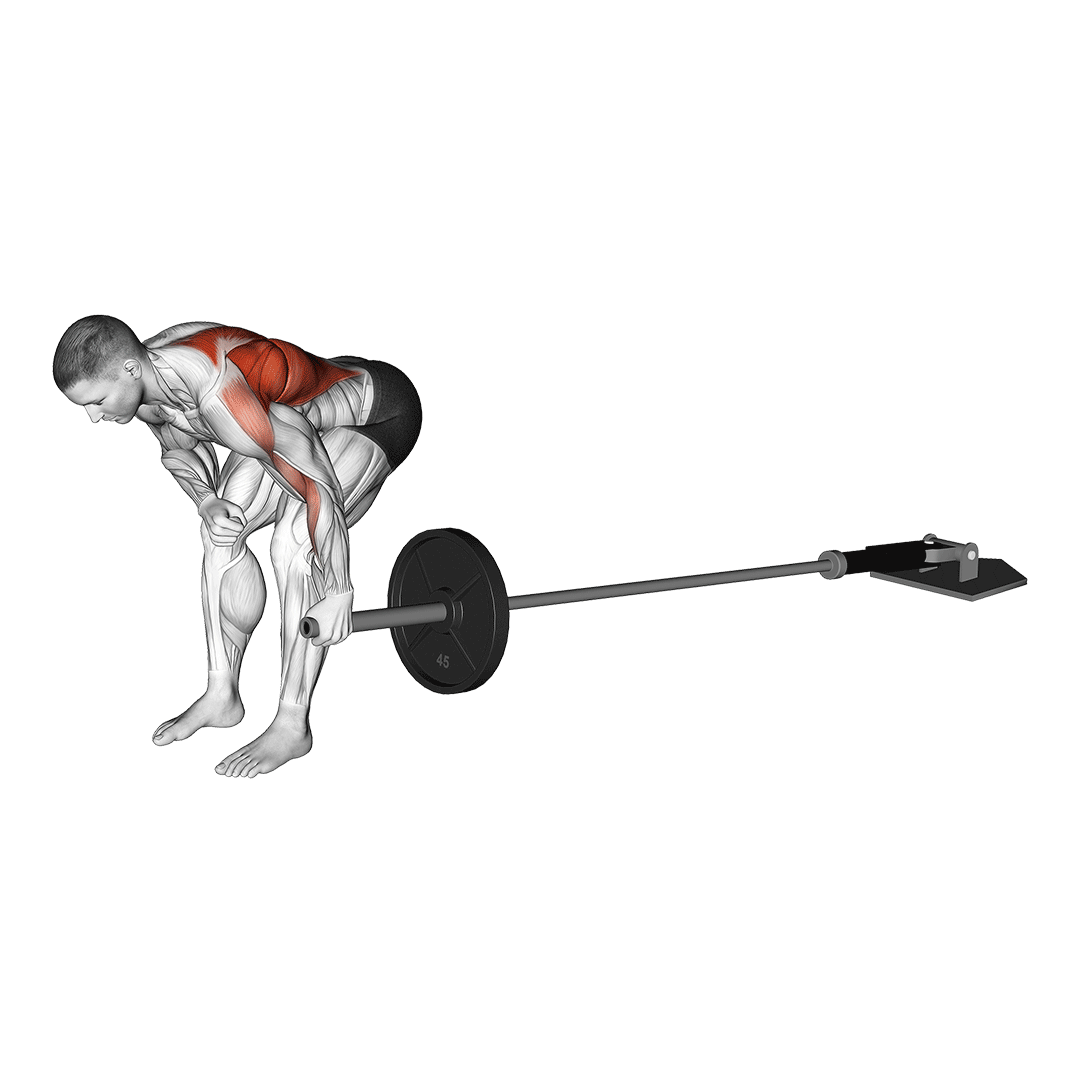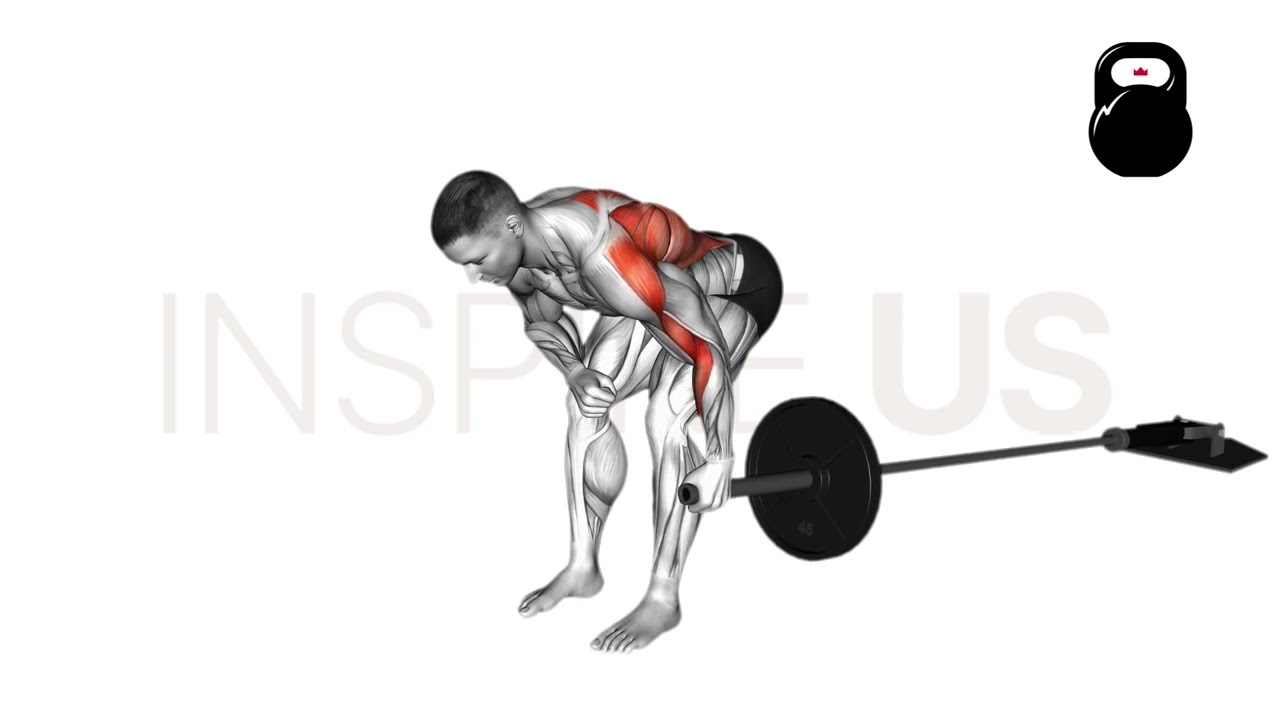Single Arm Landmine Rows Exercise Overview: Muscles Worked and More
Single arm landmine rows are a free weight back exercise involving one end of a barbell being inserted into a landmine apparatus - creating a more natural bar path, a more horizontal trunk, and allowing for a one-handed rowing movement without the use of a dumbbell.
In most cases, the single arm landmine row is used as a primary compound movement for driving the development of both strength and muscle mass throughout the entire back.
Single Arm Landmine Row at a Glance
Equipment Requirements
Barbell, Weight Plate(s), Landmine (Optional)
Main Muscles Targeted
Latissimus Dorsi, Trapezius, Biceps Brachii, Rhomboids
Difficulty
Moderate
Sets, Reps, and Load Recommendations
3-5 Sets of 6-12 Repetitions at a Moderate or Heavy Load
If No Landmine is Available
If no landmine is available for use, lifters can instead wedge the opposite end of the bar beneath a sufficiently heavy and sturdy object. So long as the bar path remains the same, doing so presents no issues.
How to Do a Single Arm Landmine Row
- To perform a repetition of the single arm landmine row, the lifter will first position themselves parallel to the bar, facing in the same direction as the weighted end with the working side closest to it.
- Hinging forwards at the hips until the trunk is nearly horizontal, the lifter grips the neck or end of the bar with their working hand, ensuring that the plates will not interfere with completing a full range of motion.
- Keeping the lower back neutral, the knees bent and the upper arm close to the side of the body, the lifter contracts their lats and pulls the barbell towards their ribs.
- As the bar is raised upwards and the elbow bends behind the trunk, the lifter retracts the shoulder blade on the working side of their body - fully retracting it once the apex of the rep has been reached.
- Concentric phase now completed, the lifter then allows the weight of the bar to slowly disengage their shoulder blade as the working arm is lengthened downwards.
- Once the arm is once again extended beneath the trunk as it grips the bar, the repetition is considered complete. Don’t forget to train the opposite side as well.
Additional Tips:
For lifters with particularly large weight plates, standing parallel to the bar may limit their range of motion.
To correct this, the lifter may either stand perpendicular to the end of the bar (a la Meadows rows) or otherwise far enough ahead that the plates are essentially behind the body.
In addition, considering this is the one-handed variant, the opposite arm may rest atop the knee or a nearby object for greater stability and support.
Sets and Reps Recommendation:
As is the case with many other types of barbell row, aiming for heavier weights and a moderate amount of volume is ideal for general muscular development of the back.
Anywhere between 3-5 sets of 6-12 repetitions with a moderate or heavy load should suffice.
What Muscles do Single Arm Landmine Rows Work?
Single arm landmine rows are a compound movement, meaning that more than one muscle group exhibits intense dynamic contraction as the exercise is performed.

Among these are the latissimus dorsi, rhomboids, biceps brachii and trapezius muscles - all of which act as primary mobilizers.
Alongside the aforementioned are the anterior deltoids, teres muscles and the infraspinatus, where they fulfill the role of secondary mobilizers.
Common Single Arm Landmine Rows Mistakes to Avoid
To get the most out of single arm landmine rows, the following mistakes should be corrected if present.
Poor Range of Motion
Perhaps the most common mistake encountered with landmine rows is a poor range of motion.
Failing to complete a full ROM can cause many back muscles to be underworked, leading to poor training response and the creation of secondary issues like sticking points.
To ensure a full ROM, each repetition must feature a high point with the elbow bent parallel to the sides of the body, if not raised further above. Likewise, the scapula should be largely disengaged with the working arm extended beneath the trunk at the start and end of each rep.
Failing to Control Eccentric
In order to truly maximize development of the back muscles, the eccentric (lowering) phase of the landmine row should be performed far slower than the initial concentric phase.
Failing to control the latter half of the repetition will not only lead to suboptimal muscular gain, but also potentially jeopardize the safety of the shoulder joint and lower back.
Apart from avoiding lifting more weight than they can handle, the lifter should aim to also stretch out the length of each eccentric phase up to 3 seconds. The concentric half, on the other hand, can be somewhat more rapid.
Poor Lower Back Curvature
As the single arm variation of landmine row allows for an even more horizontal trunk, maintaining the safety of the lower back is all the more important.

Allowing the lower back to hyperextend - or, worse, to enter a state of flexion - will increase pressure and strain on not only the soft tissues therein, but also the underlying lumbar spine as well.
To prevent injuries to this area, the core should be lightly braced, with the head facing forwards and the actual orientation of the trunk achieved through hinging at the hips, rather than bending at the waist.
Who Should Do Single Arm Landmine Rows?
Single arm landmine rows are excellent for correcting imbalances, maximizing horizontal pulling strength and building thickness in the mid-back.
Bodybuilders in particular will find the movement to be perfect for their training needs and style.
However, despite these benefits, it is indeed somewhat more tricky as far as lower back safety and fatigue to stimulus balance is concerned. Novices or experienced lifters already following an intense training program may be better served with the two-handed variant instead.
References
1. Lincoln, Merrick & Sapstead, Gareth & Moore, Kayla & Weldon, Anthony. (2022). Exercise Technique: The Landmine Row. Strength & Conditioning Journal. Publish Ahead of Print. 10.1519/SSC.0000000000000751.

